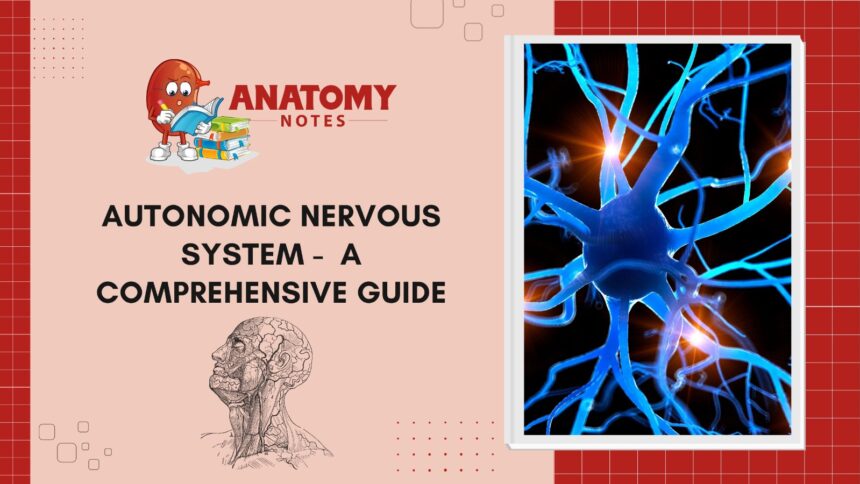Introduction to the Autonomic Nervous System
Welcome to a journey inside your body, where the intricate workings of the autonomic nervous system come to light. From regulating your heart rate to controlling your digestion, this system plays a crucial role in maintaining balance and harmony within you. Let’s delve deeper into everything you need to know about the autonomic nervous system and uncover its fascinating secrets together!
Structure of the Autonomic Nervous System
The autonomic nervous system, often referred to as the involuntary nervous system, plays a crucial role in regulating internal bodily functions. When it comes to its structure, the ANS is made up of two main components: the sympathetic nervous system and the parasympathetic nervous system.
These two divisions work in harmony to maintain balance within the body. The sympathetic branch prepares us for action by increasing heart rate and releasing adrenaline during stressful situations, commonly known as fight or flight response. On the other hand, the parasympathetic division helps us relax and conserve energy through activities like digestion and rest.
Although both branches have distinct functions, they ultimately work together seamlessly to keep our bodies functioning optimally without us even realizing it. It’s truly fascinating how intricately our bodies are designed to maintain equilibrium effortlessly.
Functions of the Autonomic Nervous System
The functions of the Autonomic Nervous System are crucial for our body to maintain balance and respond to different situations without us even having to think about it. It controls involuntary bodily processes like heart rate, digestion, breathing, and more.
This system works behind the scenes, regulating our internal environment by constantly adjusting to external stimuli. Whether you’re running from danger or relaxing after a meal, your autonomic nervous system is working hard to keep everything in check.
It’s like the silent conductor of a complex orchestra, coordinating various bodily functions seamlessly. Without it, we wouldn’t be able to adapt to changing circumstances quickly or efficiently.
Understanding how this intricate system operates gives us insight into how our bodies function on a deeper level. From maintaining blood pressure to controlling pupil size, the autonomic nervous system plays a significant role in keeping us alive and well.
Comparison: Autonomic vs. Somatic Nervous System
The autonomic nervous system and somatic nervous system play distinct roles in the body. While the somatic nervous system controls voluntary movements like walking or talking, the autonomic nervous system regulates involuntary functions such as heart rate and digestion.
In terms of control, the somatic system allows conscious control over skeletal muscles, while the autonomic system operates involuntarily without needing conscious effort. Furthermore, the somatic nerves originate in the spinal cord, whereas autonomic nerves arise from both the brain and spinal cord.
Another key difference lies in their effects on organs: the somatic system affects skeletal muscles directly, while the autonomic system influences smooth muscle, cardiac muscle, and glands indirectly through neurotransmitters.
Understanding these differences is crucial for grasping how our bodies function seamlessly to maintain internal balance.
Divisions of the Autonomic Nervous System
The Autonomic Nervous System is a complex network that controls involuntary bodily functions, divided into two main branches – the Sympathetic and Parasympathetic Nervous Systems. These divisions work in harmony to regulate various physiological processes without conscious effort.
The Sympathetic Nervous System triggers the “fight or flight” response when faced with stress or danger, increasing heart rate, dilating pupils, and releasing adrenaline to prepare the body for action. On the other hand, the Parasympathetic Nervous System promotes relaxation and digestion by slowing heart rate, constricting pupils, and enhancing nutrient absorption.
These contrasting divisions of the Autonomic Nervous System ensure a delicate balance between arousal and relaxation in response to different stimuli. Understanding how these systems interact is crucial in maintaining overall health and well-being.
Sympathetic Nervous System: Fight or Flight Response
The sympathetic nervous system is like your body’s turbo boost button. When faced with a threat or stressor, it kicks into high gear to prepare you for action. Heart rate increases, breathing quickens, and muscles tense up – all in the name of getting you ready to fight off danger or make a speedy getaway.
This “fight or flight” response is essential for survival in challenging situations. It’s like having an internal alarm system that alerts your body to be on high alert when needed most. The sympathetic nervous system ensures that you can respond swiftly and effectively when faced with adversity.
While this heightened state of arousal can be beneficial in short bursts, chronic activation of the sympathetic nervous system can have negative effects on overall health and well-being. Finding ways to manage stress and promote relaxation is crucial for maintaining a healthy balance between the sympathetic and parasympathetic systems.
Understanding how the sympathetic nervous system operates can help us better navigate stressful situations and support our overall health and resilience in facing life’s challenges.
Parasympathetic Nervous System: Rest and Digest Response
The Parasympathetic Nervous System is like the yin to the sympathetic nervous system’s yang. It’s all about rest and digest, putting the body in a state of relaxation after dealing with stress. When this system kicks in, heart rate slows down, digestion increases, and pupils constrict.
Picture yourself lounging on a cozy couch after a hearty meal – that’s the parasympathetic nervous system at work. It helps your body recover and rejuvenate, promoting optimal conditions for digestion and nutrient absorption.
This branch of the autonomic nervous system allows your body to conserve energy and focus on essential functions like repairing tissues and maintaining homeostasis. So next time you feel calm after a stressful situation or find yourself enjoying a good night’s sleep, thank your parasympathetic nervous system for its role in keeping you balanced and healthy.
Neurotransmitters in the Autonomic Nervous System
Neurotransmitters play a crucial role in the Autonomic Nervous System (ANS). They are chemical messengers that transmit signals between neurons, allowing for communication within the body. In the ANS, two main neurotransmitters are involved: acetylcholine and norepinephrine.
Acetylcholine is primarily released by parasympathetic nerves and some sympathetic nerves. It helps regulate processes like heart rate, digestion, and bladder function. On the other hand, norepinephrine is mainly released by sympathetic nerves and is involved in the fight or flight response.
The balance of these neurotransmitters is essential for maintaining homeostasis in the body. Disruptions in their levels can lead to various health issues, such as hypertension or digestive problems. Understanding how neurotransmitters function in the ANS provides insight into treating autonomic nervous system disorders effectively.
Researchers continue to explore new ways to target specific neurotransmitter pathways to develop more precise treatments for conditions related to autonomic dysfunction. Stay tuned for further advancements in this fascinating field of study!
Role of the Autonomic Nervous System in Homeostasis
The autonomic nervous system plays a crucial role in maintaining homeostasis within the body. It is responsible for regulating various internal processes to ensure that the body’s internal environment remains stable and balanced.
Through its control over heart rate, blood pressure, digestion, and respiratory rate, the autonomic nervous system helps to keep our bodies functioning optimally. Whether we are resting or in a stressful situation, this intricate system works tirelessly behind the scenes to keep everything in harmony.
When external factors disrupt our equilibrium, such as sudden temperature changes or emotional stressors, the autonomic nervous system jumps into action to restore balance. Its ability to adapt quickly and efficiently is vital for our overall well-being.
By understanding how the autonomic nervous system contributes to homeostasis, we gain insight into the complex mechanisms that allow us to thrive in diverse environments. This delicate interplay between different bodily functions underscores the importance of this regulatory system in maintaining health and vitality.
Clinical Relevance: Autonomic Nervous System Disorders
Autonomic Nervous System disorders can disrupt the body’s vital functions, leading to various health issues. These conditions can manifest in symptoms such as abnormal heart rates, blood pressure fluctuations, digestive problems, and more. Disorders like autonomic neuropathy or dysautonomia can significantly impact a person’s quality of life by affecting their daily activities.
Managing Autonomic Nervous System disorders often requires a multidisciplinary approach involving healthcare professionals specializing in neurology, cardiology, gastroenterology, and other fields. Treatment options may include medications to regulate heart rate or blood pressure, lifestyle modifications to improve symptoms, and therapy to enhance overall well-being.
It is crucial for individuals experiencing symptoms of autonomic dysfunction to seek medical attention promptly for proper evaluation and management. Early detection and intervention play a key role in effectively addressing Autonomic Nervous System disorders and improving patient outcomes.
Research and Advancements in Understanding the Autonomic Nervous System
Research in understanding the autonomic nervous system has been advancing rapidly, shedding light on its intricate functions and complexities. Scientists are delving deeper into the role of neurotransmitters and receptors within this system, uncovering new pathways for potential treatments. Cutting-edge technologies like brain imaging and genetic studies are revolutionizing our comprehension of how the autonomic nervous system operates in health and disease.
Recent studies have highlighted the connection between the autonomic nervous system and various medical conditions such as heart disease, gastrointestinal disorders, and mental health issues. By dissecting these relationships, researchers aim to develop more targeted therapies that can effectively modulate autonomic function.
Innovative approaches like biofeedback training and vagus nerve stimulation are being explored as non-invasive methods to regulate autonomic responses. These breakthroughs offer promising avenues for individuals suffering from dysautonomia or other related disorders. The ongoing research endeavors continue to reshape our understanding of this vital regulatory system, paving the way for future advancements in personalized medicine tailored to individual autonomic profiles.
Conclusion and Summary: Key Takeaways about the Autonomic Nervous System
As we wrap up our exploration of the autonomic nervous system, let’s reflect on some key points. Understanding its structure and functions is crucial for appreciating its role in regulating involuntary bodily processes. The comparison between the autonomic and somatic nervous systems sheds light on their distinct functions.
The divisions—sympathetic and parasympathetic—show how the body responds to different stimuli, either gearing up for action or winding down for relaxation. The intricate dance of neurotransmitters orchestrates these responses with precision.
In maintaining homeostasis, the autonomic nervous system plays a vital role in keeping our internal environment stable amidst external changes. However, disruptions can lead to various disorders that impact quality of life.
Advancements in research continue to deepen our understanding of this complex system, offering new insights into potential treatments for related conditions. Remember, the autonomic nervous system is an integral part of what keeps us ticking without conscious effort.
Frequently Asked Questions (FAQs)
Q1. Can stress impact the autonomic nervous system?
Yes, chronic stress can dysregulate the balance between the sympathetic and parasympathetic systems, leading to various health issues.
Q2. How does the autonomic nervous system affect heart rate?
The sympathetic division increases heart rate, while the parasympathetic division decreases it.
Q3. Are there ways to regulate the autonomic nervous system?
Yes, practices like deep breathing exercises, meditation, and yoga can help regulate autonomic function.
Q4. Are there ways to regulate the autonomic nervous system?
Disorders such as dysautonomia, postural orthostatic tachycardia syndrome (POTS), and diabetic neuropathy can affect ANS function.
Remember that understanding how your body’s automatic processes work is essential for overall well-being. Keeping a healthy lifestyle and managing stress levels can positively impact your autonomic nervous system function. Stay informed and take care of your body—it’s always working hard behind the scenes to keep you functioning at your best!




